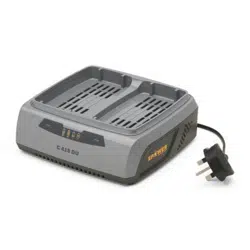Loading ...
Loading ...
Loading ...

EN - 3
– neutralise with lemon juice,
vinegar or other mild acids.
• If chemicals contained in the battery come into
contact with the eyes, follow the instructions
above and seek medical assistance.
• Before use, check that the output voltage
and current of the battery charger are
suitable for charging the battery pack.
• If the output polarity does not match the
charging polarity, DO NOT use the charger.
• For indoor use only.
• DO NOT open the cover under any
circumstances. If the cover is damaged,
the charger can NO longer be used.
• DO NOT charge non-rechargeable batteries.
CHECKING BATTERY CAPACITY
level of the battery. See the diagram below:
1
2
Lights Capacity
4 green
lights
Fully charged battery
3 green
lights
Battery is 70% charged
2 green
lights
Battery is 45% charged
1 green light Battery is 10% charged and
needs recharging immediately.
Lights
The battery has less than 10%
power reserve and needs
recharging immediately.
The "Warning" icon lights up
when the overtemperature
or undertemperature
protection triggers, or when
the battery is faulty.
SAFETY NOTES AND PRECAUTIONS
1. DO NOT disassemble the battery.
2. Keep out of the reach of children.
3. DO NOT expose the battery to fresh or salt
water, store it in a cool and dry place.
4. DO NOT place the battery in hot places,
5. DO NOT switch the negative and
positive battery terminals.
6. DO NOT connect the positive and negative
terminals of the battery to metal objects.
7. DO NOT hit, tap or stand on the battery.
8. DO NOT weld or drill the battery
with nails or other sharp objects.
9. If the battery loses chemicals that come
into contact with your eyes, do not rub
them but rinse thoroughly with water.
10. Stop using the battery if it produces
unusual smells, becomes hot or changes
colour/shape and looks abnormal.
11. If the power cable of this tool is damaged, it
must be replaced by the manufacturer or his
in order to reduce any resulting risk.
4. ECO-FRIENDLY DISPOSAL
OF THE BATTERY
The following toxic and corrosive
materials are found within the battery
pack used with this tool: Lithium-ion is a
toxic material.
All toxic materials should be
disposed of properly to prevent
environmental contamination.
Before disposing of damaged or broken
lithium-ion battery packs, contact your
local waste disposal agency or the local
Environmental Protection Agency for
specic information and instructions.
Dispose of batteries in a certied lithium-
ion recycling and/or disposal facility.
If the battery pack cracks or breaks,
with or without chemical leakage, do
not recharge or use it. Dispose of and
replace it with a new battery pack.
DO NOT ATTEMPT TO REPAIR IT!
In order to avoid accidents and risks of
re, explosion or electric shock and to
prevent damage to the environment:
– Cover the battery terminals
with strong adhesive tape.
– DO NOT attempt to remove or destroy
any part of the battery pack.
– DO NOT attempt to open the battery pack.
Electrolytes released from battery
pack chemical leakage are corrosive and
toxic. Do NOT allow chemical substances
Loading ...
Loading ...
Loading ...
